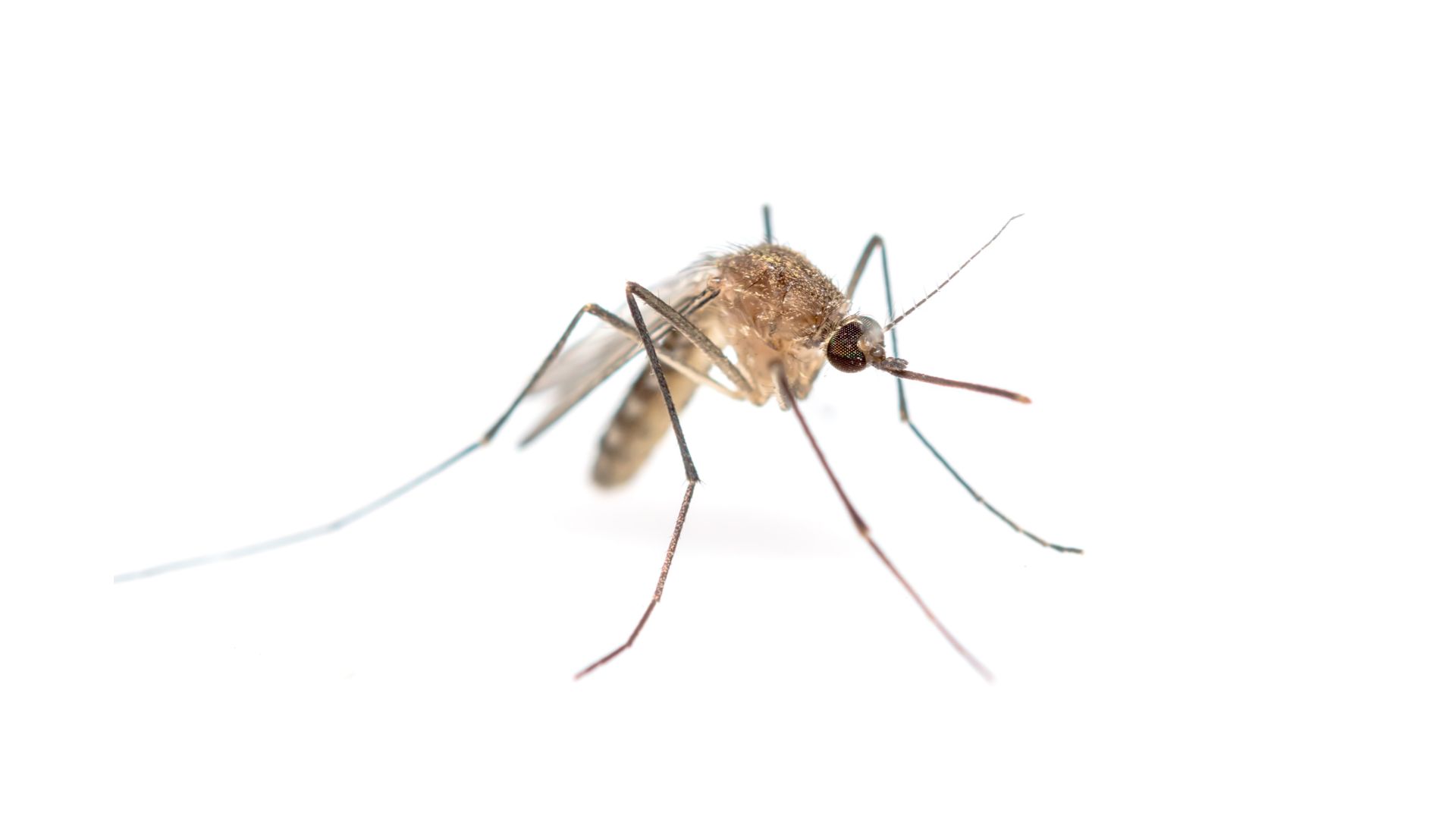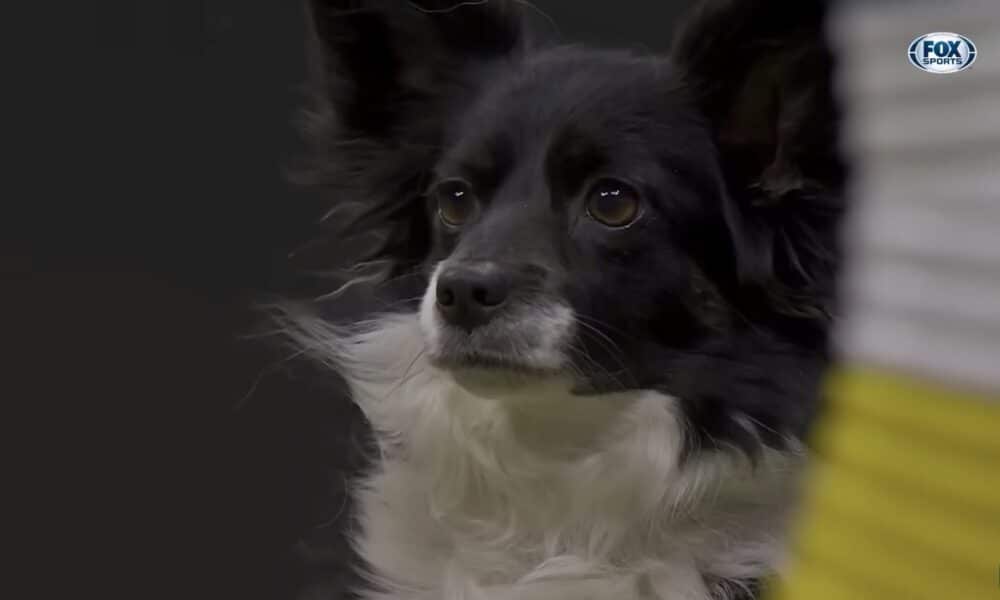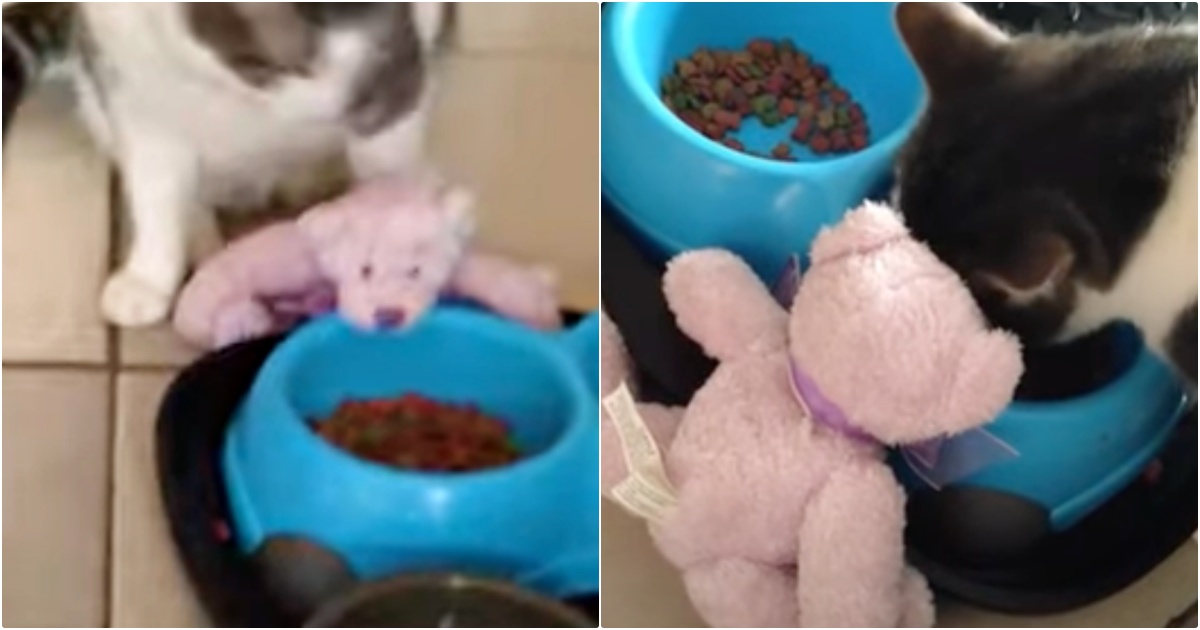Mammary Most cancers In Canine: 2024 Information

What Is A Mammary Tumor in Canine?
Can canine get breast most cancers? Sadly, they will!
In veterinary drugs, mammary most cancers in canine is one thing that we see approach too usually recently. Neoplastic growths originating from the tissue of mammary glands in canine describe these tumors. Tumors of the mammary tissue are evident in all animals, however most frequently in canine and cats.
These mammary tumors might be benign (non-cancerous) or malignant (cancerous), with the potential to metastasize to different organs or close by lymph nodes.
Varieties of Mammary Tumors in Canine
Veterinary oncology faces fairly a problem relating to breast most cancers in canine as a result of a major proportion of all mammary tumors present malignant traits. These particular neoplasias stem from the mammary glands’ epithelial cells, and their metastatic potential and organic habits can fluctuate.
Beneath are a number of the various kinds of canine tumors and their properties.
Benign Mammary Tumors
Benign mammary gland tumors in canine have the traits of cells that can’t invade the encompassing tissues or metastasize to distant organs.
The most typical benign varieties of mammary tumors are fibroadenomas (well-defined, wobbly, and transferring below the pores and skin with glandular tissue composition) and adenomas (smaller, much less complicated, originating from the glandular epithelium).
Malignant Mammary Tumors
All malignant tumors have one factor in frequent – aggressive progress and quickly spreading all through the physique.
Predominant among the many malignant tumors are carcinomas, which might be stable, papillary, tubular, or anaplastic.
Sarcomas, however, are much less frequent however extra aggressive. They originate from the connective tissue of the mammary gland.
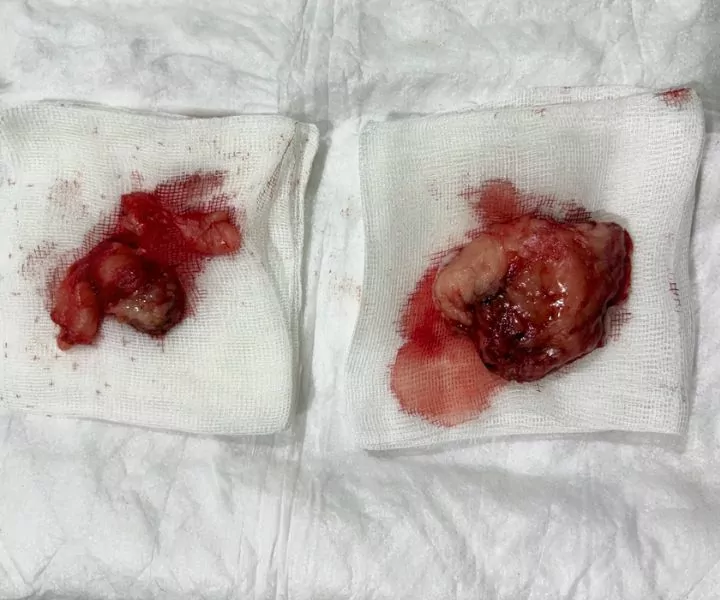
Combined Mammary Tumors
These kind of tumors can include a number of parts, resembling connective and epithelial tissue, on the similar time. They are often benign or malignant, and their habits will depend upon the organic traits of the malignant half.
Inflammatory Mammary Carcinomas
This kind of canine breast most cancers may be very aggressive, and it grows quickly, inflicting extreme irritation alongside the way in which. Medical indicators fairly often appear to be mastitis and might be misdiagnosed. The prognosis may be very poor.
Canine Breast Most cancers: Indicators and Signs
Indicators and signs of canine breast most cancers can fluctuate primarily based on the character or malignancy of the tumor, its location, and its measurement. It’s crucial to acknowledge the indicators of breast most cancers as early as attainable to supply well timed intervention and remedy and doubtlessly a greater prognosis and end result for the affected affected person.
What ought to we search for when searching for mammary tumors in canine?
Palpable Lots
The lumps are essentially the most notable and customary in presenting mammary tumors. These lumps can seem anyplace alongside the mammary tissue and are noticeable below the fingers with palpation.
These lumps can fluctuate from very small (like a rice grain) to very large (like a tennis ball). The lumps might be singular (just one lump) or a number of (like a bunch of laborious grapes bunched collectively).
Look Change
In addition to the lumps, the tissue surrounding them can change its look. It will possibly change into reddened, swollen, ashy, or ulcerative. The continuity of the pores and skin across the lumps will seem distorted.
Discharge
Some mammary tumors may cause fluid buildup within the mammary ducts, which can seem clear, bloody, or pus-like. Mammary gland discharge most frequently signifies further underlying pathology of that gland.
Discomfort and Ache
Some mammary tumors can go unnoticed by the canine, particularly within the early levels, however others might be fairly painful to the contact. The canine would possibly lick obsessively, chunk the tumor, or change into aggressive when touched the place the most cancers is.
Systemic Indicators
In circumstances the place the mammary tumor is malignant, notably if there’s metastasis to distant organs, the canine would possibly present indicators of
- Lethargy
- Problem respiration
- Inappetence
- Weight reduction
- Coughing
- Lameness
- Weak point
- Enlarged lymph nodes
Causes of Mammary Tumors in Canine
Mammary most cancers in canine is affected firstly by genetics, then hormones, and lastly environmental elements. It’s vital to know their etiology to make sure early detection and prevention of canine mammary tumors.
Genetics
Current research present proof that sure breeds of feminine canine are extra susceptible to develop canine tumors than others. These breeds are Poodles, Dachshunds, and Yorkshire Terriers. Analysis in veterinary oncology is ongoing and attempting to identify the genetic markers accountable for tumorigenesis [1].
Hormones
Reproductive hormones have a robust hyperlink with the event and progress of canine mammary tumors, particularly progesterone and estrogen. Estrogens are primarily secreted within the ovaries (small quantities within the adrenal glands and the adipose tissue) and play a major position within the reproductive well being of the bitch.
Progesterone is a hormone produced primarily by the adrenal cortex and a few by the ovaries. It performs a vital position in ovulation and through being pregnant as a result of whereas the bitch is pregnant can be excreted by the corpus luteum to guard and hold the fetuses alive until time period.
Exposing mammary tissue to those hormones over time is taken into account to extend the chance of growing breast most cancers. Research have proven that spaying feminine canine earlier than their first purpose reduces the chance of growing mammary tumors to 0.5% [2].
Setting and Life-style
Though not researched sufficient, the specialists consider that sure danger elements, resembling food plan, weight problems, and publicity to environmental carcinogens, can contribute to the event and progress of mammary most cancers in canine.
Reproductive Historical past
The danger of mammary tumors in bitches will increase with age, and the proportion of documented circumstances is greater in canine bred after the second oestrus. Bitches which have by no means been bred and stay unspayed additionally danger growing mammary tissue tumors.
How is Breast Most cancers in Canine Identified?
Diagnosing canine breast most cancers requires a number of diagnostic instruments, beginning with a bodily examination. Some mammary tumors might seem linked to the belly wall if the bitch is in good bodily situation; some might droop freely within the pores and skin tissue.
Earlier than choosing surgical procedure, some veterinarians might carry out FNA (wonderful needle aspiration). The process requires utilizing a skinny needle with which the veterinarian will puncture the tumor to gather cells for cytology. These enable us to find out the character of the most cancers, whether or not it’s benign or malignant.
When surgical procedure is concerned, the tumors are virtually at all times despatched to biopsy, both a complete tumor or a pattern, to find out the definitive character of the most cancers. Veterinarians advise, when eradicating the mammary tumor, to spay the bitch to regulate the recurrence of the tumors.
X-rays and MRIs will help to find out the diploma of the tumor and the opportunity of metastasis. The first metastatic websites seemed for on the x-ray are the lungs and the regional lymph nodes, however mets within the liver and spleen have additionally been evident.
Canine Mammary Most cancers Phases Defined
The staging course of includes categorizing tumors in keeping with the Tumor, Node, Metastasis (TNM) system, which includes 5 classifications:
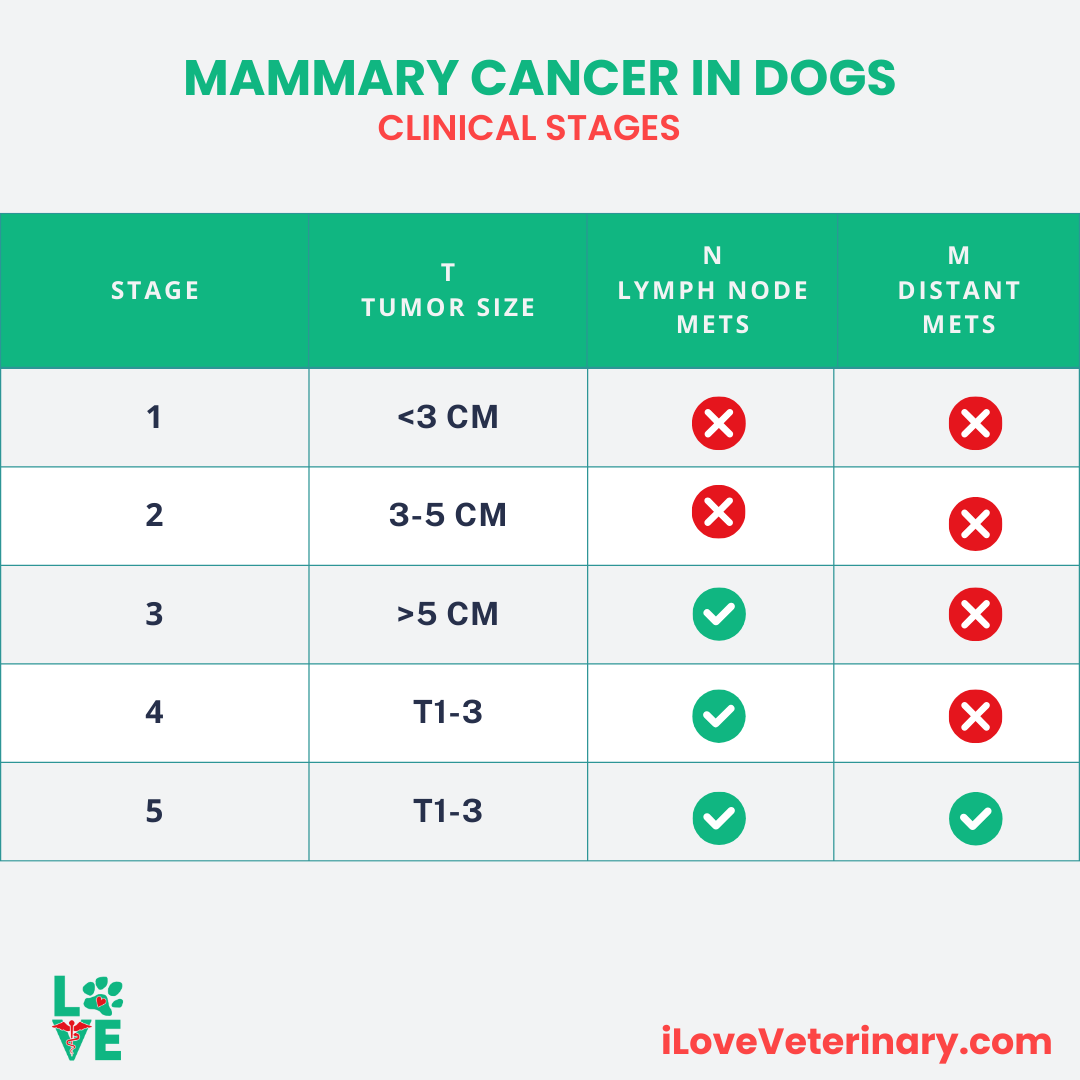
- Stage 1 (T1N0M0): Tumor measurement is lower than 3 cm, with no regional or distant metastasis.
- Stage 2 (T2N0M0): Tumor measurement ranges from 3 to five cm, with no regional or distant metastasis.
- Stage 3 (T3N0M0): Tumor measurement exceeds 5 cm, with no regional or distant metastasis.
- Stage 4 (T1-3N1M0): Any tumor measurement with proof of regional metastasis however no distant metastasis.
- Stage 5 (T1-3N0-1M0): Any tumor measurement with or with out regional node metastasis and proof of distant metastasis.
Therapy Choices for Mammarian Most cancers in Canine
Veterinarians ought to tailor the remedy of breast most cancers relying on the tumor sort (whether or not the tumor is benign or malignant), the stage of the most cancers, and naturally, the bitch’s general well being.
Surgical procedure
The most typical remedy path is surgical excision of the tumor with a transparent margin of wholesome tissue. Generally, this would possibly imply {that a} partial or whole mastectomy is important.
Chemotherapy
When the identified tumor is malignant, chemotherapy or radiation remedy is likely to be a attainable possibility, particularly if the chance for metastasis is excessive. The selection of which chemotherapy drug will likely be an possibility will depend upon the kind of tumor. A few of the most typical chemotherapy medicine utilized in treating mammary tumors in canine are Doxorubicin, Carboplatin, Mitoxantrone, and Paclitaxel.
Radiation
We are able to use radiation remedy to regionally management the tumor, particularly in circumstances the place the most cancers is inoperable, or the surgical margins are very slender.
Medication and Hormone Remedy
In some circumstances, docs contemplate canine hormonal therapy and provides anti-estrogen medicine to the affected person. With hormonal remedy, we’re concentrating on the hormonal affect on the expansion of the tumor, however that is restricted and particular to sure varieties of mammary tumors.
The hormonal, or anti-estrogen, remedy that’s in play in these circumstances is selective estrogen receptor modulators (SERM) and diethylstilbestrol medicine. Examples of SERM are Raloxifene, Tamoxifene, and Torimefene. The vets and pet house owners administer these medicine in pill type.
What to Anticipate After Canine Mammary Tumor Therapy
After treating a mammary tumor in a canine surgically, the prognosis and the anticipated outcomes will fluctuate drastically, whether or not the most cancers is benign or malignant, the presence (or absence) of metastasis when identified, and the overall well being of the affected person.
The incision, or surgical procedure website, will get well inside two to a few weeks, relying on the dimensions of the excised tumor. Sustaining correct wound administration is essential, as cleansing the wound every day and stopping the canine from licking and biting the incision website with an Elizabethan collar. The stitches, if current, are eliminated after 10 to 14 days post-surgery.
Some tumors, normally aggressive malignant sorts, can regrow on the identical website or adjoining on this therapeutic interval, however that is uncommon.
Observing the incision website for indicators of an infection, swellings, or wound opening is essential.
After the therapeutic interval, veterinarians advise conducting common veterinary checkups to seek for indicators of tumor recurrence or the expansion of recent tumors, utilizing bodily examination and, if crucial, x-ray imaging. If metastasis happens, the most typical organs affected are the lungs, liver, and others.
If surgeons fully take away tumors with benign traits, the canine has a superb prognosis and may count on to guide a traditional and wholesome life. When the most cancers is malignant, the prognosis will fluctuate on the kind of tumor and aggressiveness.
Mammary Tumors in Canine: Life Expectancy and Consequence
The prognosis and outcomes for canine mammary tumors depend upon the tumor’s sort, measurement, and stage and the canine’s general well being. These variables are essential for the veterinarian and the pet house owners to determine life like expectations and make choices for the remedy and care of the canine.
Canine normally have a very good or wonderful prognosis with benign tumors if surgeons take away the tumor surgically. These benign mammary tumors sometimes develop slowly and don’t invade the encompassing tissues, and the chance for mets is minimal. The probability of recurrence or issues after surgical procedure is minimal.
With regards to malignant mammary tumors, the prognosis will depend upon a number of elements. Excessive-grade tumors and those identified at a later stage, particularly ones with metastasis and lymph node involvement, have a really poor prognosis. Confined, early-stage tumors may have a greater prognosis.
General survival time after surgical procedure will depend upon the sort and grade of the tumor, the place benign and small, wholly excised tumors have a greater survival fee of a few years. Sufferers with high-grade tumors and/or metastasis are likely to reside a couple of months to a yr.
The Backside Line
Mammary most cancers in canine is one thing that we see fairly often at veterinary clinics. Research present that spaying can decrease the possibility of a mammary tumor to 0.5%, however not all pet house owners know this.
Mammary tumors might be of benign or malignant character, and this determines the outcomes and prognosis for our oncological sufferers. Surgical removing is at all times the golden rule for breast most cancers in canine, and typically, chemo and radiation remedy are an possibility after surgical procedure.
Life expectancy will considerably depend upon the dimensions, sort, and grade of the tumor, with benign tumors having wonderful outcomes, whereas sufferers with malignant ones usually are not so fortunate.
FAQ
What Does Breast Most cancers Look Like in a Canine?
Mammary most cancers in canine has a lumpy look, making the mammary glands look uneven when examined. These lumps fluctuate in measurement.
How Quick Do Mammary Tumors in Canine Develop?
The progress fee of canine mammary tumors depends upon the kind of tumor. Benign tumors develop slower and malignant quicker. Additionally, hormones play a major position in breast most cancers progress, and extra fast progress is clear throughout and after the bitch’s oestrus cycle.
What’s the First Signal of Mammary Most cancers in Canine?
The primary signal is palpating a lump within the mammary glands.
Ought to I Take away My Canine’s Mammary Tumor?
You must focus on the removing of a mammary tumor with a veterinarian. The vet ought to completely look at and decide the very best choices for each affected person.
Is Breast Most cancers in Canine Painful?
Sure, breast most cancers in canine might be painful.



